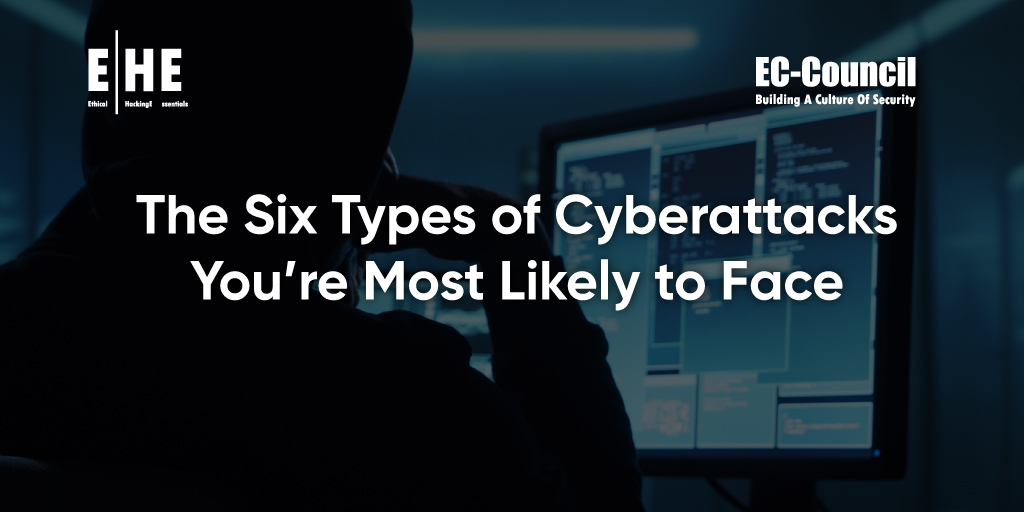The Six Types of Cyberattacks You’re Most Likely to Face
Do you know what the most common types of cyberattacks are? If you’re not sure, you’re not alone: Many people don’t know the different types of cyberthreats that are out there. But as more and more businesses move their operations online, it’s important to have the knowledge and skills necessary to protect yourself against cybercriminals.
In this article, we’ll cover some of the most common cyberattacks and explain how you can defend yourself against them. To learn more, check out EC-Council’s Certified Secure Computer User (C|SCU) certification, which is designed to teach you about the types of cyberattacks that you’re most likely to encounter. The C|SCU course covers a wide range of security topics, from avoiding identity theft to recognizing social engineering tactics.
1. Phishing Attacks
Phishing attacks are one of the most common types of cyberattacks. These occur when cybercriminals send emails that appear to be legitimate but are actually designed to manipulate the recipient into providing sensitive information, clicking on a malicious link, or downloading a malicious attachment.
Attackers can successfully pull off a phishing attack by sending a message that contains an urgent request for help, which tricks users into clicking on a link that will supposedly provide additional details or direct them to the correct location. Phishers may also execute attacks by creating websites that look extremely similar to legitimate ones; if a user isn’t paying close attention, it can be easy to mistake the fake website for the real one.
2. Social Engineering Attacks
Social engineering attacks are another common form of cyberattack. Social engineering techniques attempt to trick individuals into providing sensitive information to an attacker or enabling the attacker to use their computer for the attacker’s purposes without the user’s knowledge.
This kind of attack requires not just technical knowledge but also a certain level of social skills on the part of the attacker. Unlike most other cybercrime methods, social engineering relies almost entirely on human interaction. Social engineering is also one of the most challenging types of cyberattacks to prevent because it’s not always easy to identify that an attack is taking place.
3. Ransomware Attacks
A ransomware attack starts when hackers take control of a target’s computer and encrypt the files stored on it. The attacker then demands that the target pay a ransom to decrypt the files, usually in the form of an untraceable means of payment, such as Bitcoin.
This type of cyberattack is typically carried out using Trojans or another type of malware spread using phishing emails or social engineering techniques. Ransomware costs businesses more than $75 billion per year, according to PurpleSec’s (2021) ransomware statistics report.
4. Malware and Virus Attacks
Cybercriminals often attempt to install malware or a virus on a target’s computer to gain access to it and use it for their own purposes—for example, launching an attack against another machine or network. According to Purple Sec’s (2021) malware statistics, 92% of malware is delivered by email.
If you find that your computer is running much more slowly than usual or is crashing frequently, an attacker might be using it without your knowledge. If you notice any unusual activity on your machine, try to figure out what’s causing the problem as soon as possible. To protect yourself against malware and virus attacks, it’s important to keep all of your antivirus and security software up to date and to practice safe browsing habits.
5. Denial-of-Service (DoS) Attacks
A denial-of-service (DoS) attack is one of the most common types of cyberattacks. DoS attacks are designed to take an online resource offline by flooding it with so much traffic that it crashes or becomes extremely slow. Cybercriminals might carry out DoS attacks because they want to gain access to information stored on a machine or website or to disrupt the activities of the person or organization responsible for running the targeted resource.
If you’re responsible for managing websites or machines that store important data, try using services like Elastic Compute Cloud (EC2) and Amazon Web Services (AWS) to protect your resources against DoS attacks. EC2 and AWS provide automatic scaling options that increase server capacity as you experience more traffic, making it more difficult for attackers to successfully carry out a DoS attack.
6. Spyware and Adware Attacks
Spyware and adware cyberattacks often go undetected. These forms of attacks generally involve the installation of software applications on a user’s computer without their knowledge or consent. Cybercriminals typically carry out these types of attacks because they want to use the target’s machine for their own reasons, such as engaging in cyber espionage or delivering ads for products that generate revenue for the attackers.
You can protect yourself against spyware and adware by keeping your antivirus and security software up to date, avoiding suspicious websites and apps, and regularly checking your browser settings to make sure they haven’t been changed without your knowledge.
Improve Your Security Knowledge with EC-Council
As technology advances, so do the methods of cybercriminals. Their motivations may vary, but their tactics are constantly evolving. That’s why it’s important to stay aware of the different types of cyberattacks you could face and take steps to protect yourself and your organization.
At EC-Council, we’ve developed the comprehensive C|SCU cybersecurity certification program to help you do just that. With our expert-designed training on identifying and mitigating security risks, you can rest assured that your business is safe from the latest cyberthreats.
Are you ready to step up your cybersecurity game? Check out EC Council’s C|SCU program—get certified today!
References
PurpleSec. (2021). 2021 cyber security statistics. https://purplesec.us/resources/cyber-security-statistics/









